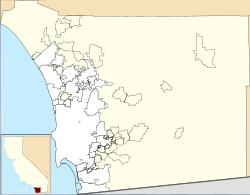Estudillo House | |
San Diego Historic Landmark No. 14A | |
 Main entrance | |
| Location | 4000 Mason Street, San Diego, California |
|---|---|
| Coordinates | 32°45′14.32″N 117°11′44.81″W / 32.7539778°N 117.1957806°W |
| Built | 1827 |
| Architectural style | Spanish Colonial |
| NRHP reference No. | 70000143 |
| CHISL No. | 53 |
| SDHL No. | 14A |
| Significant dates | |
| Added to NRHP | April 15, 1970[3] |
| Designated NHL | April 15, 1970[4] |
| Designated CHISL | 1932[1] |
| Designated SDHL | November 6, 1970[2] |
The Casa de Estudillo, also known as the Estudillo House, is a historic adobe house in San Diego, California, United States. It was constructed in 1827 by José María Estudillo and his son José Antonio Estudillo, early settlers of San Diego and members of the prominent Estudillo family of California, and was considered one of the finest houses in Mexican California.[5] It is located in Old Town San Diego State Historic Park, and is designated as both a National and a California Historical Landmark in its own right.[1][4]
Besides being one of the oldest surviving examples of Spanish architecture in California, the house gained much prominence by association with Helen Hunt Jackson's wildly popular 1884 novel Ramona.[6] The Casa de Estudillo is one of three National Historic Landmarks in Southern California that were closely tied to Ramona, a novel of Californio life shortly after the American acquisition of California; the other two are Rancho Camulos and Rancho Guajome.
- ^ a b "Casa de Estudillo". Office of Historic Preservation, California State Parks. Retrieved October 13, 2012.
- ^ "Historical Landmarks Designated by the San Diego Historical Resources Board" (PDF). City of San Diego. Archived (PDF) from the original on March 18, 2018. Retrieved November 18, 2012.
- ^ "National Register Information System". National Register of Historic Places. National Park Service. January 23, 2007.
- ^ a b "Estudillo House". National Historic Landmark summary listing. National Park Service. Archived from the original on November 14, 2007. Retrieved November 17, 2007.
- ^ Patricia Heintzelman (September 1975). National Register of Historic Places Inventory-Nomination: Estudillo House. National Park Service. and Accompanying 7 photos, exterior and interior, from 1975, 1958, 1960, and 1968. (2.27 MB)
- ^ Kyle, Douglas E.; Hoover, Mildred Brooke (2002). Historic Spots in California. Stanford University Press. p. 337. ISBN 0-8047-4483-1. Archived from the original on July 14, 2021. Retrieved December 14, 2020.



